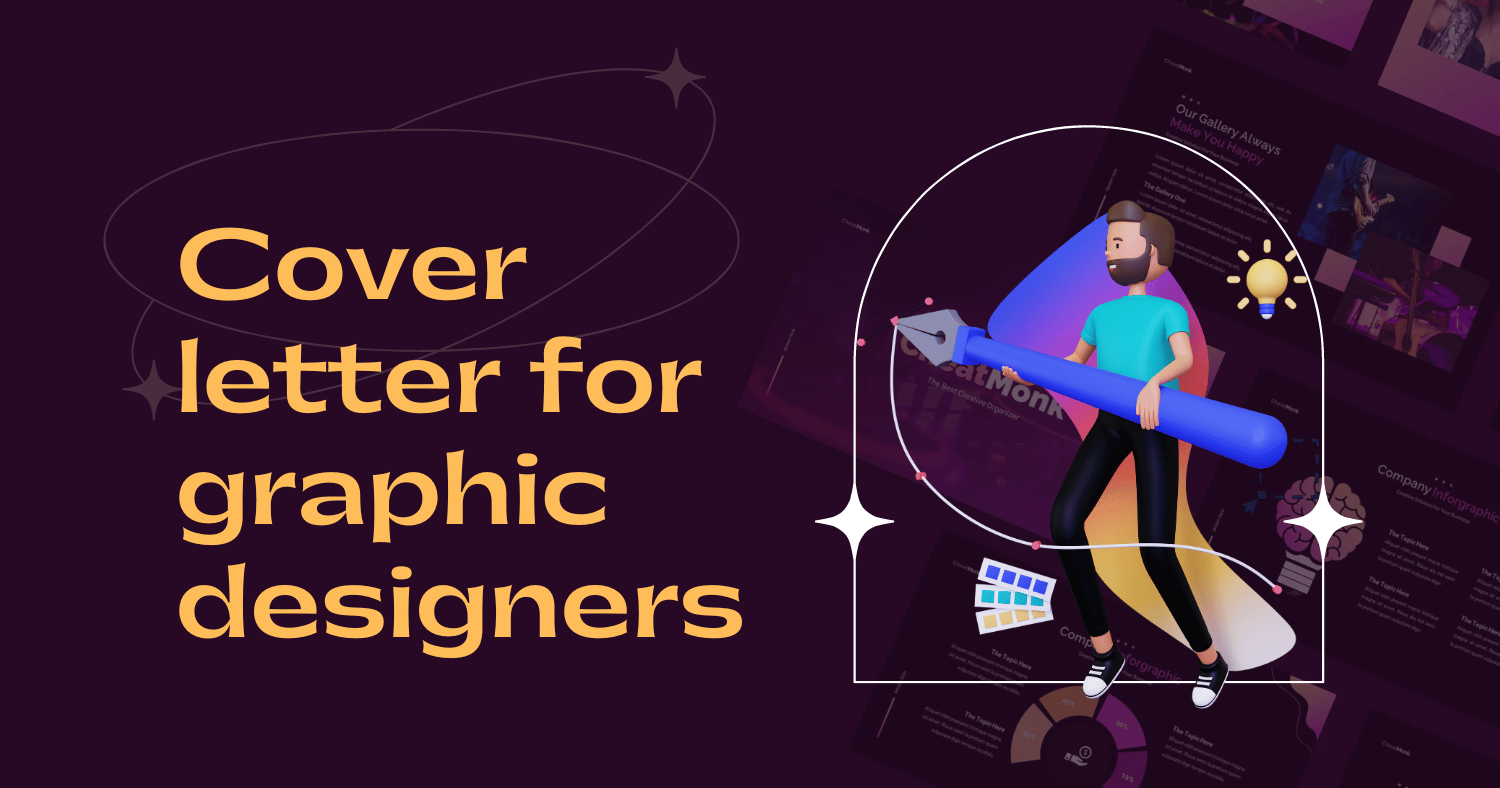Cover letter for graphic designers
Discover how to create a strong cover letter to improve your chances of getting the desired graphic design position. Learn what to put in your cover letter, what to leave out, and how to make the most of it by personalizing it.
When reviewing designer applications, one of the first things potential employers will see is the cover letter, which should be paired with the résumé. These brief letters enable you to market yourself and your skills to the design firm you’re applying to, and they also give your CV some perspective. The ideal way to approach it is to consider a cover letter as an employer’s first impression of your interview and portfolio, providing them with a quick way to determine how interested you are in the job and how capable you are of handling the required tasks. These letters are frequently fewer than 500 words long, but even though they are brief, they are essential because hiring managers look at them first when faced with a sea of applications.
How to Write a Cover Letter for a Graphic Designer
Writing your first cover letter can be challenging because you need to write in this genre, and it takes time and effort regularly. It might not be easy to convince a hiring manager to give you a job offer in a brief letter, and it may take several attempts to get it right. To increase your chances of success, you should put a few things in every cover letter.
Greetings and personal details
Despite its unique features, a cover letter is still a letter, and it should start with an official greeting. If applicable, you should first call the hiring manager by name. If not, you can address the letter to a “hiring manager or committee.” Next, give a brief introduction and mention that you plan to apply for the job that has been offered. It may seem unnecessary to provide this formal introduction since it is obvious that you are seeking a job, but it is essential.
First Paragraph
After introducing yourself and announcing your intention to apply for the position, you should grab the reader’s attention with a brief overview of your skills and experiences as a designer. This could be an introduction to your professional background as a designer or a summaForce Regenerate Thumbnailsry of the critical elements of your CV. Since the more detailed aspects of this history and design philosophy will be more prominently displayed on your CV, and if they’re relevant, they should be brief and direct in your interview.
Experience and background in design
Use this space to effectively explain how you want a hiring manager to view your supplemental job materials while summarizing aspects of your background and design experience. The cover letter is a fantastic location to draw readers’ attention to parts of your resume and other job materials that might only be apparent after further explanation. For instance, your resume might include a line describing a specific project you worked on or a professional award you were given. Your job letter is an opportunity to contextualize your CV lines and explain why they are essential to the reader.
Particular Arguments for the Position
It would help if you elaborated on your desire for the job you are looking for in the later section of the cover letter. Make sure you take the time to thoroughly explain to your potential employer why you are a suitable fit for the position. Instead of just copying and pasting a job letter that already exists, candidates must use this section to demonstrate that they have carefully read the job posting in question and tailored their letter to the position.
Concluding Remarks and Expert Verdict
It would help if you formally thanked the hiring manager or committee for their time and thoughtfulness after the letter. This is the end of a short letter, so it should be quick, but it’s still necessary to end it kindly. Even though the letter has a digital signature, you should still sign it.
Five Tips for Writing a Cover Letter for a Graphic Designer
Cover letters can be challenging to create because they must include pertinent information in a condensed amount of space. It would help if you started by introducing yourself, outlining your qualifications for the job, putting critical components of your other application papers into context, indicating your availability, and ending with a formal letter. A few things are worth considering to help make your letter as successful as possible since a lot is riding on this correspondence.
First Tip: Draw the readers’ attention to your work materials.
Providing the hiring manager with arrows to guide them through the remainder of your job materials is one of the most crucial parts of a job letter. Suppose you want to emphasize your professional achievements on your resume. In that case, devote a fair amount of space in your cover letter explaining how your candidate’s accomplishments showcase your qualities. Let’s say you want your readers to focus more on the materials in your portfolio. If so, your cover letter should describe how you believe each project in your portfolio to be a showcase of your abilities. How you use the space in your letter to direct the reader to the sections of your application that you want them to focus on will vary depending on the job letter.
Tip #2: Avoid using this area to express regret about your resume.
It could be tempting to use the letter’s space to justify away things like a job gap or a concern about your formal training since a significant portion of the letter entails contextualizing resume elements and giving employers information that won’t be evident. This is a waste of space in the letter that will make your reader feel less optimistic while they read it and might even call their attention to those problems. Though you might be expressly questioned about these issues during the interview process, it is helpful to understand how you will handle these gaps or absences. Instead of using the letter to emphasize the shortcomings in your other employment materials, you want to use it as an opportunity to showcase your finest self.
Tip #3: Try to personalize your message as much as possible.
Ensuring your cover letter is tailored specifically for the position you are applying for is one of the most crucial aspects of writing. You should review the job description and contact the employing company to learn more about the tasks they will assign to you or that you will be working on. If print advertising design is the firm’s primary business, include a statement in your job letter outlining your readiness to begin working on this project. If the company has a more diverse clientele, you must persuade the hiring manager that you are willing to work in a setting where your responsibilities are ever-changing. This will differ from job letter to job letter, but showing the hiring manager that you took the time to tailor your letter specifically for the position is crucial.
Tip #4: Use as many words as possible.
A job letter for most positions should be five hundred words, not including headers, introductions, and conclusions. Due to the limited amount of words and space, potential employees should consider maximizing the available area carefully. Using a grammar checker on a letter might be a simple way to help trim excessively wordy sentences. Other aspects of it include selectivity in selecting the information to include and optimizing the amount of information you can convey to a potential employer in the fewest feasible words. While you shouldn’t eliminate a compelling element of your application in favor of condensing it, two equally persuasive elements might be more critical than a protracted tale or explanation.
Tip #5: Request input
You should seek feedback on your letters from instructors, professors, and other experts you know. This is important for a few reasons. First and foremost, most aspiring graphic designers will want particular guidance from experts who have written these letters effectively because this is the first time they will have written a cover letter. This input gives you another viewpoint on whether the letter effectively conveys your intended ideas. This is a second important reason to do so. It is easy to assume that something is clear to you, but it may be more difficult for your readers to understand. This is perfect since it gives you additional eyes to proofread your work and detect any errors, odd phrases, or writing tics.
This type of professional feedback can be obtained, for example, through a Noble Desktop career certificate course. One-on-one career mentoring sessions, where students can get assistance and feedback on the format of their cover letters and the direction in which they take their job materials, are among the advancement services offered by these classes.

